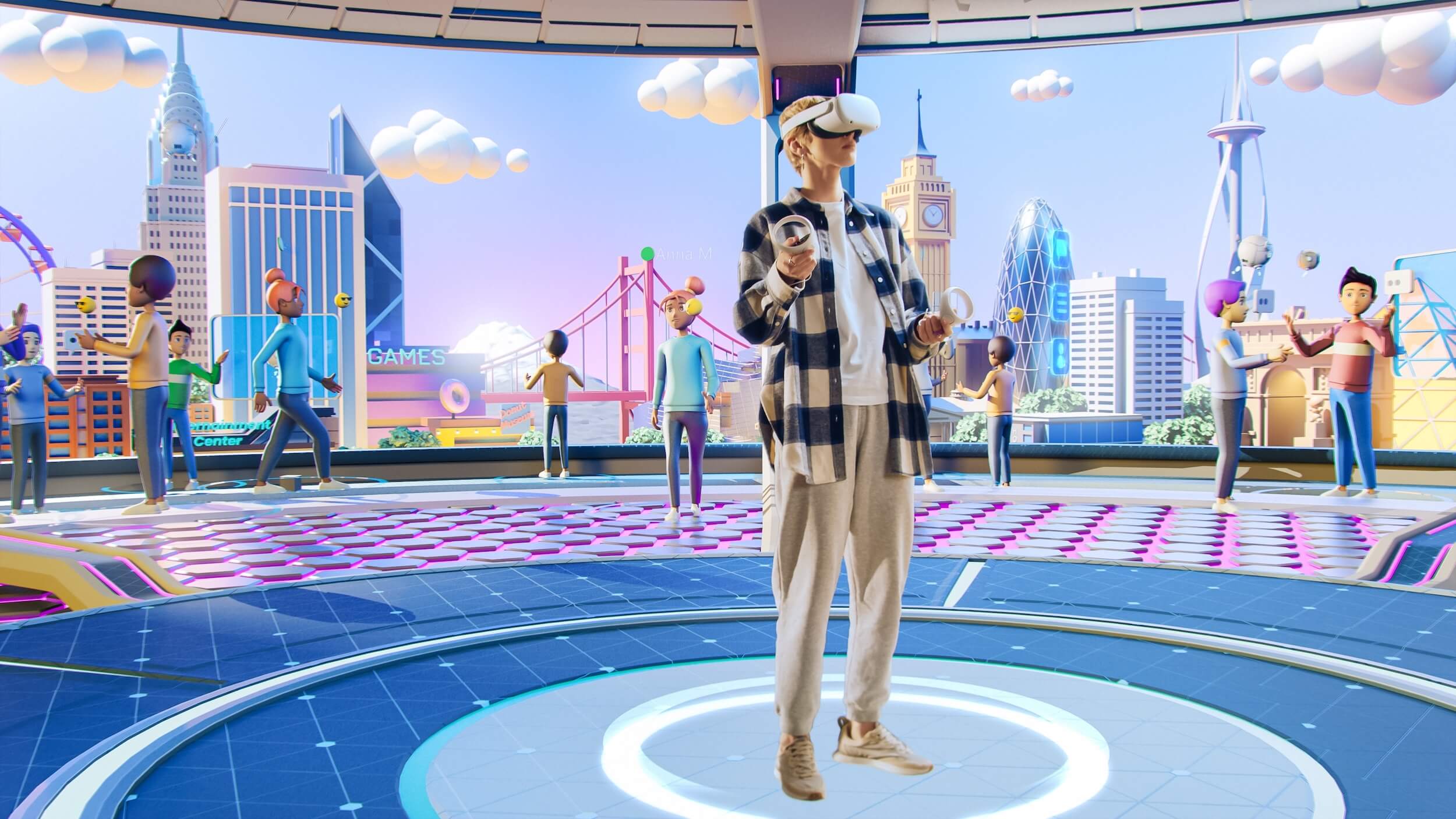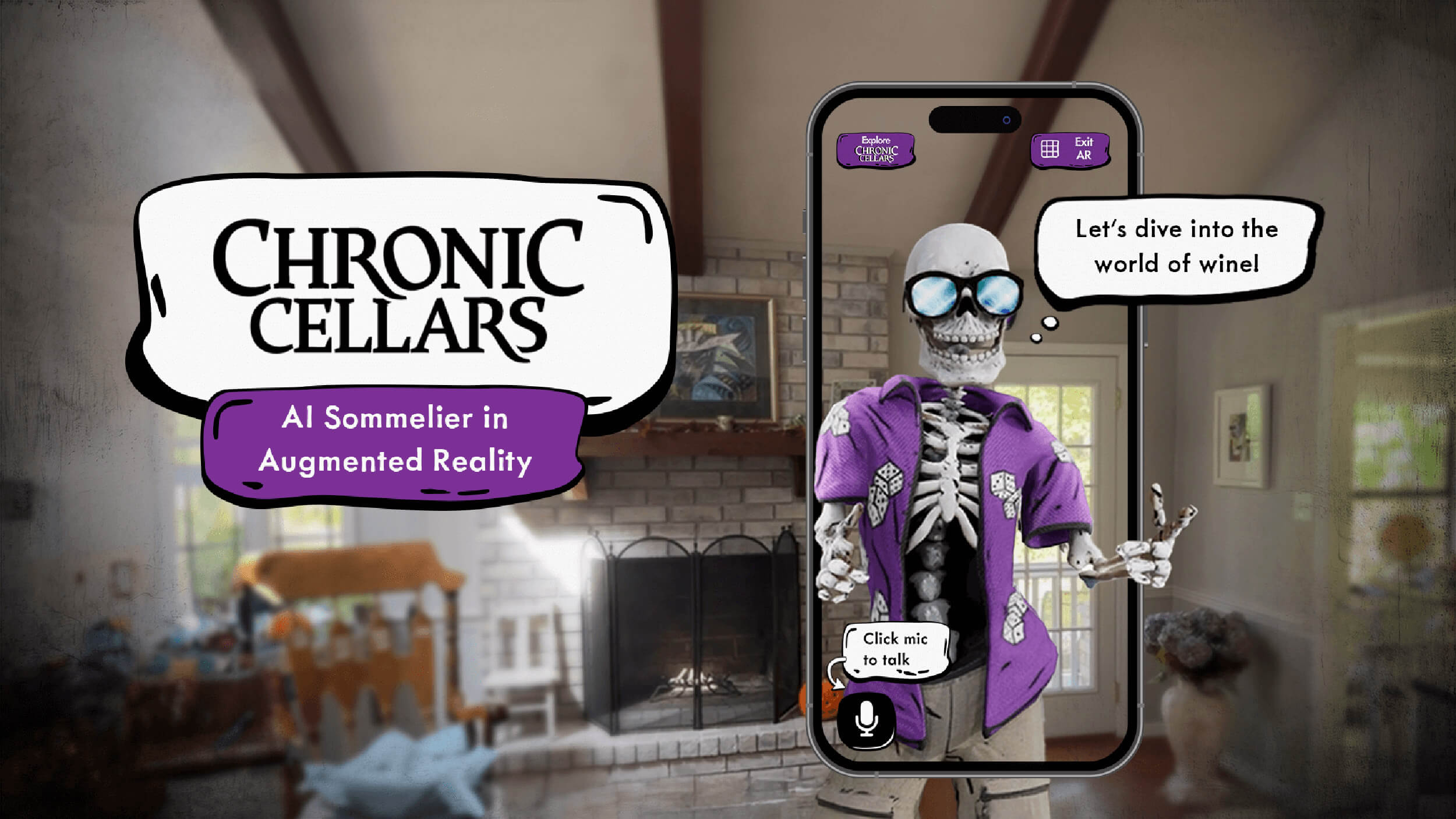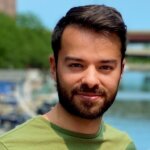From virtual reality simulations that adapt with user behavior in real time to augmented reality applications that blend digital and physical worlds, AI is revolutionizing the immersive technology landscape. Far beyond mere entertainment, AI is ushering in an era where immersive content is becoming faster, more engaging, and widely-used across multiple industries.

For businesses, the infusion of AI into immersive technologies offers a game-changing toolkit. Brands are better positioned than ever to forge stronger connections with their audiences, deliver experiences that resonate on a personal level and create a lasting impact. Let’s delve into the value you can create for your brand today from this perfect combination of fast-growing technologies.
Key Takeaways
- Artificial intelligence can vastly increase processing power and speed, enabling unbelievably responsive and personalized experiences. Richly detailed graphics, adaptive sound and dynamic narratives are all made possible or enhanced by AI.
- Experiences with higher levels of responsiveness can increase immersion and drive greater emotional connection. This can heighten user engagement and forge strong brand relationships.
- Immersive experiences have dozens of use cases across multiple sectors, from entertainment and gaming to enterprise and e-commerce.
- Major brands are already investing in and experimenting with AI, and AI-powered XR experiences.
Keep up to date
Sign up to our newsletter for exclusive updates and content, delivered directly to your inbox.
How AI Enhances Personalization and Interactivity
Nothing draws in a user like a personalized experience. Just over 70% of consumers expect companies to deliver personalized interactions, and even more get frustrated when this expectation is not met. Digitally-created environments feel more real when they respond to the person using them, and the faster and more dynamic the response the more the user can feel immersed in the experience. AI provides the processing power and speed to generate those elaborate personalized responses instantaneously.
Major technology companies including Microsoft, Google, and Meta have already integrated generative AI into services and platforms, allowing them to instantaneously generate video call backgrounds, environments and search queries for the user. And that’s just the start.
How is AI Used in Behavior Analysis and Preference Tracking?

AI can efficiently analyze large volumes of data, detect patterns and predict what a user might do or might want to do next. This is especially valuable for creating personalized XR experiences, as models can generate content that is more relevant to a user’s preferences and needs. Tailored narrative arcs, shopping suggestions and training materials can make immersive experiences more engaging, and ultimately drive far greater value for both the user and creator.
AI and Adaptive Storytelling
AI enhances adaptive gameplay by analyzing player behavior, adjusting game elements in real-time, and offering personalized challenges. Dynamic narratives and mission customization present users with compelling choices, opening up new possibilities and unique experiences. Players can follow different paths based on past experience or skill level, or just play differently depending on their mood.
When an experience is different for every user, or different every time they play, interactions become more relevant and nuanced. This can wield substantial benefits in terms of replayability and retention.
How is AI Used in Simulation Training?
The same principles are used in narrative-driven training, presenting workers with different scenarios so they can explore the consequences of alternative decisions. Surgeons, miners and first aid responders can hone their skills in virtual environments, giving them crucial experience for use in the real world.

Another important use case is AI-powered customer service training programmes. These put workers into conversations with digital avatars which talk like real customers. Investment giant Invesco is just one of the major players trialing on-demand training environments, which simulate sales calls so employees can learn how to tackle realistic customer responses, objections and conflict. According to a PwC report, people training in an immersive VR environment completed the material four times faster and with four times as much focus as those learning in the classroom — reducing costs and increasing efficiencies for enterprise training at scale.
How Can AI Create Visual Content?
AI-assisted visuals can take immersive content to a new level. Realistic 3D models, optimized textures, and dynamic adaptability create visually stunning and engaging environments, enhancing immersion and making the virtual experience more compelling, enjoyable, and memorable for users. From entertainment and gaming to education, heightening the sense of realism can have a huge impact on the overall effectiveness of the content.
How Does AI Make Imagery More Realistic?
AI’s real-time processing power plays a big part. Enhanced realism comes from high-fidelity graphics and richly-detailed high-resolution textures. Lighting and shadows add depth and dimension to an environment, while real-time adaptations to a player’s movements enable them to feel truly grounded in the digital realm.
AI-generated visuals were key to Rock Paper Reality’s addictive VR motor-racing game for the Japan and USA Formula 1 Grand Prix races. Players could customize their cars for each race, which meant using pre-generated complex depth maps and textures with AI.
To take an example from the world of retail e-commerce, the IKEA Place app uses AI to show potential customers how a particular piece of furniture would look in their home. It doesn’t just place a photo of a sofa on a picture of their living room, though: the app accurately scales both the room and the item, and matches lighting and shadows to give the customer a genuine feel for how the item would appear.
Similarly, RPR’s View In The Room solution for Saatchi Art gave collectors the opportunity to see how over 1 million artworks would look in their home. The AR feature grew mobile transactions 100% year-on-year, outpacing desktop.
Let’s chat
Not sure where to start? Book a free strategy call with us to get started! No strings attached.

AI Object Segmentation for World Awareness
Immersive experiences become more believable and impactful when virtual objects behave as if they were in the actual space. AI can recognize and differentiate people, items and surfaces in an image or video in a process called object segmentation. It’s ideal for use cases like medical imaging, which can highlight anomalies in a person’s scan, or self-driving cars, which can distinguish (and then avoid) vehicles and obstacles.
In AR, object segmentation adds world awareness — for example, a fictional digital object can be shown bouncing differently when it ‘comes into contact’ with real surfaces like a hard floor or a sofa. This was a crucial element in RPR’s highly replayable AR experience for Ben & Jerry’s, in which players could build their own sundae. Similarly, attendees of Adobe Max 2023 loved opening their AR app and seeing digital elements ‘bounce’ down the sides of the LA Convention Center to introduce the day’s schedule.
AI-driven Character Design and Avatars
Artificial intelligence can also have a huge impact on the characters a user may encounter within an experience. AI algorithms can influence behaviors, enabling characters to react realistically to in-game events, while Natural Language Processing (NLP) facilitates communication and comprehension. AI technologies can also enable gesture recognition, making facial expressions and interactions more lifelike and compelling.
Again, it isn’t just fantasy settings in gaming or entertainment experiences that benefit from these advances. The same principles apply in enterprise solutions and AR experiences. When AI is applied to IP, famous characters can be brought to life and transformed into interactive branded ambassadors. RPR created an AR experience around the winemakers Chronic Cellars’ iconic skeleton character Purple Paradise. Trained on an extensive dataset of the company’s wines, the AI-powered NPC sommelier was able to converse, offer tasting notes and deliver tips and information.
How is AI Used in Audio and Sound Design?
Artificial intelligence plays an integral role in sound design for immersive worldbuilding. From real-time audio analysis and adaptive soundtracks to spatial audio processing and voice cloning, AI is a powerful tool in enhancing the realism and richness of simulated environments.
An experience’s sound mix is a powerful tool for immersive worldbuilding, because noises perceived to be coming from different directions help the user understand the geography of a virtual environment. AI-driven audio and sound technologies leverage artificial intelligence to enhance and customize auditory experiences.
AI and Spatial Audio
Spatial audio recreates a 3D sound experience, mimicking the way humans receive sound input in the real world. Audio for an experience may be recorded with microphones set up in a 3D binaural arrangement, mirroring the way sounds may come from the left, right, front or back. The technology enables users to experience sound from multiple directions, helping them to understand the geography of a virtual environment and access enhanced spatial awareness and realism. AI can intelligently mix audio content to suit different spatial configurations and simulate effects such as reverberation.
AI and Positional Audio Effects
As with the visuals of an experience, the power of AI makes sound more responsive and dynamic. In storytelling terms, positional sound pulls a player’s attention to a specific point in space to watch events unfold. Sound conjures story moments, from a loud jump scare to a more subtle noise a player may strain to hear. By drawing from a library of sounds or music ‘stems’, AI can build dynamic soundtracks that fit a narrative as it unfolds. In a game, music may become more exciting as a player chooses an action sequence. In an AR experience, users might trigger sounds with movement.
Natural Language Processing and Voice Recognition
Voice recognition is powered through a branch of AI known as Natural Language Processing (NLP). It allows users to talk to digital characters and enables those characters to respond in contextually appropriate ways. In gaming, this technology can be leveraged to influence story arcs and convey decisions. In training scenarios, customer service employees can talk to virtual customers just as they would on the phone or face-to-face.
AI and Voice Cloning and Training
AI can be used in voice cloning, enabling an actor’s voice to be extrapolated beyond the content captured in a recording. This technology turns a speaker’s performance into building blocks to assemble new dialogue in real time. Musicians like Charli XCX, Sia and Grimes are among the cutting-edge performers giving permission for their voices to be cloned. Instead of restricting users to pre-programmed scripts, AI opens up a world of dynamic and compelling interactions.
How is AI Used to Enhance the User Experience?
AI can make an experience feel more natural and reduce the friction and learning curves found in other applications. When a player has to follow a tutorial or spend time figuring out how to interact, it can become a barrier to getting on with the job or enjoying the experience. Thanks to AI, a user can use natural language to speak with characters and give commands, enabling them to easily navigate an environment as if it were a real place.

The value of an intuitive and natural experience can’t be overstated, as it allows a player to enter an experience and simply begin exploring. This is also great for accessibility, as features like text-to-speech empower visually or functionally-impaired users to interact too.
What Are The Future Trends and Considerations For AI?
AI is only growing smarter, faster and more efficient. So it’ll continue to unlock and enhance the power of augmented reality, virtual reality and mixed reality. Experiences will become even more responsive, more adaptive and more personalized. As AI develops, the use of natural language with dynamic visuals and sound will create ever more realistic characters for users to interact with. And this has already extended into the worlds of entertainment, marketing, gaming, hospitality and all kinds of corporate uses.
AI-driven AR overlays will provide an even greater level of responsiveness. AI tools like ChatGPT and Midjourney are currently making headlines for their ability to generate text and images on demand. Combine that with AR and you have AR experiences which go beyond simply displaying pre-programmed digital elements. Instead, they will generate truly adaptive overlays of content specifically responding to what you’re looking at.

Ethical Implications and Challenges of Combining AI and Immersive Technologies
As AI continues to develop, transparency and accountability are essential. Privacy, data protection and consent are key considerations for creators of XR content to be aware of.
Large Language Model (LLM) systems are trained on pre-existing information, so artists must give consent to their creative property being used. When using voice cloning, actors must agree to use of their voice beyond the limits of a single script.
As AI draws on source material, it can perpetuate biases and ideas from the original creators. Users should be mindful to avoid repeating unconscious biases or unacceptable ideology. They should also guard against the introduction of inaccurate information – sometimes called ‘hallucinations’ – into the finished product.
Grow Your Brand with AI-powered Immersive Storytelling

Artificial intelligence and extended reality make a perfect pairing. AR and VR environments are enormously impactful because they immerse users into narratives that evoke powerful emotional connections. The more dynamic, organic and responsive the experiences, the deeper the connection and the higher the engagement. AI’s processing speed, coupled with its ability to generate human-like responses, supercharge the adaptive nature of an XR experience.
The AI revolution is happening right now, and already driving groundbreakingly immersive activations. Forward-thinking brands are energizing employees and thrilling customers with XR experiences and enterprise solutions across all kinds of industries. For AI and XR, this is the perfect moment.
At RPR, we’ve already built experiences using AI, and we could do it for you too. Get in touch now.
Frequently Asked Questions About AI and Immersive Experiences
How is AI used in 3D modeling?
3D modeling is a perfect use of AI, as it typically requires a lot of processing power. AI quickly produces realistic textures and shading for different surfaces in 3D characters and environments.
How does AI help virtual reality?
AI’s real-time processing speed can enable virtual reality applications to respond instantly to whatever the user may do. From conversations with digital characters to richly-detailed graphics, AI-powered enhancements add to the believability of VR experiences.
What’s the relationship between augmented reality and machine learning?
Augmented reality adds digital elements like text or animation onto what a person actually sees in the real world. Machine learning involves algorithms that analyze huge quantities of data to find patterns. By collecting and analyzing user choices, behavior and information, machine learning enables AR experiences to evolve.
How does AI impact virtual worlds?
AI’s speed and processing power means even high-quality graphics and audio can be efficiently generated in response to user actions. This opens the way for highly-detailed, richly-rendered and incredibly immersive experiences which take users on dynamic and varied journeys.
